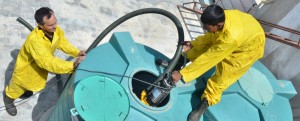Nov – 16: PUBLIC INTEREST
Dirty tanks cause for water contamination
Test findings reveal that direct water supply is free from pathogens  
Drinking water or potable water is defined as water safe enough to be consumed by humans. The most common and widespread health risk associated with drinking water is contamination either directly or indirectly by human or animal excreta, particularly faeces. Faecal contamination is determined by the presence of Coliform bacteria, particularly E.coli.
When water contaminated with pathogens is used for drinking or food preparation it can cause waterborne diseases like cholera, diarrhoea, typhoid, amoebiosis and jaundice. World Health Organization (WHO) data reveal that in India 780,000 deaths every year are attributable to contaminated water.
Our project
Access and delivery of safe drinking water in India varies from state to state and even within a state. For the purposes of this project, sponsored by the Ministry of Consumer Affairs (MoCA), Government of India, we tested 47 samples of water from five sources in different localities of Ahmedabad.
Test findings revealed both good and bad news. The good news was that water taken from the four direct sources were free from pathogens. The bad news was that all samples of water collected from water tanks, the fifth source, were contaminated with Coliform bacteria.
We tested drinking water for four parameters: (a) visual examination; (b) TDS; (c) Coliforms and (d) E.coli. As per the Indian Standard, Coliforms and E.coli should be absent in 100ml. Also, Total Dissolved Solids (TDS), which comprise mostly inorganic salts, should not be more than 500mg/L.
Key findings
- All 7 water samples collected from tanks were contaminated with varying amounts of Coliforms and some even had E.coli. Drinking water from three sources – Narmada, Ahmedabad Municipal Corporation (AMC) and borewells, when collected from tanks, had Coliforms.
- The other 40 samples were free from Coliforms and E.coli, were clear without any particles and were odourless.
- All borewell samples and the sample from Gram Panchayat Nagar Palika water supply were found with TDS higher than the prescribed limit. The values ranged from 700-1000 mg/L.
- All samples from AMC water supply and Narmada water supply had TDS within the prescribed limit.
Keep tanks clean
Water from tanks is used for brushing teeth, bathing, washing utensils and even for cooking. As such, not cleaning tanks regularly compromises the health of people. As a resident of a building society or independent bungalow, ensure tank cleaning gets done periodically. Remember, tank water should undergo purification or filtration prior to consumption.
Impact of high TDS levels
Because of high TDS, water may taste bitter, salty or metallic and may have unpleasant odours. Some of the individual mineral salts that make up TDS pose a health hazards, particularly nitrates, sodium, sulfates, barium, cadmium, copper, and fluoride. High TDS in water also leads to excessive scaling in water pipes, heaters, boilers and household appliances. To tackle the problem, use Reverse Osmosis (RO) systems and adopt rainwater harvesting as a practice.




